Wie es in dem berühmten Lied von Baz Luhrmann heißt, ist der Versuch, ein Produkt ohne ausreichende Tests zu entwickeln und auf den Markt zu bringen, "Wie der Versuch, eine Algebra-Frage zu beantworten, indem man Kaugummi kaut."
Es ist nicht groß, sicherlich nicht clever und wird eine Menge Probleme verursachen.
Tatsächlich ist einer der häufigsten Gründe für das Scheitern der meisten Start-ups, dass es einfach keinen Markt für ihr Produkt gibt. Wenn nur wenig oder gar keine Produktforschung betrieben wird und das Team die Statistiken an das gewünschte Ergebnis anpasst ... nun, wir alle wissen, wie das läuft. Genaue Forschung ist eine solide Grundlage, auf der man aufbauen kann.

Was gilt als Produktforschungsinstrument?
Tools für die Produktforschung können unterschiedlicher Art sein, lassen sich aber in der Regel in ein paar große Bereiche einteilen. Die besten Tools für die Produktsuche sind Umfragesoftware, das Sammeln und Aufzeichnen von Kundenfeedback, Usability-Tests und A/B-Testing-Lösungen. Diese Aufzählung ist nicht erschöpfend, aber Produktforschungssoftware und -tools sammeln immer Informationen, um fundierte Entscheidungen über Nutzer und den Markt insgesamt zu treffen.
Unabhängig von der Methode der Datenerhebung müssen Sie letztlich nur Folgendes wissen:
Gründliche Produktforschung = gut!!!
Improvisation = schlecht 😢😢😢😢
Anstatt also um den heißen Brei herumzureden, finden Sie hier die ultimative Liste von Produktrecherchetools, die Ihnen ALLE Informationen zur Verfügung stellen, um gute Entscheidungen zu treffen.

Haftungsausschluss: Diese Informationen sollen Ihnen nur helfen, gute Entscheidungen bei der Produktforschung zu treffen. Ihre eigene persönliche Entscheidungsfindung... nun, das ist Ihre Sache. Machen Sie sich das Zeug zu eigen!
Produktrecherche-Tools auf ❤️❤️❤️
tl;dv
Sie können noch so gute Entscheidungen treffen und noch so spannende Antworten aus der Produktforschung erhalten, wenn Sie sie nicht richtig dokumentieren, sind Sie aufgeschmissen.
Eine genaue Dokumentation der Produktforschung ist entscheidend.
Wenn Forschungsergebnisse gesammelt werden, müssen sie allen Beteiligten in einer Weise zur Verfügung stehen, die klar definierte Forschungsziele, -methoden und -ergebnisse zeigt. Und dazu gehört auch die Stimme des Kunden.
Um sich in die Gedankenwelt Ihrer Zielgruppen und Nutzer hineinzuversetzen, müssen Sie direkt mit ihnen sprechen. Interviews sind in jeder Phase des Produktmanagement-Zyklus von entscheidender Bedeutung und stellen die wichtigste Quelle für Erkenntnisse dar. Anhand von Interviews können Sie sich ein genaues Bild davon machen, wer Ihre Nutzer sind, Personas entwickeln und erfahren, wo ihre wirklichen Schmerzen und Frustrationen liegen.

Sie könnten also auf einen Notizblock kritzeln oder versuchen, ein Diktiergerät einzurichten. Aber seien wir mal ehrlich. Das wird entweder nicht funktionieren, verloren gehen oder unglaublich voreingenommen sein.
Sie brauchen eine flotte, automatisch ablaufende, moderne Art der Dokumentation, und tl;dv ist es.
tl;dv kann als Produktrecherche-Software Ihre Meetings auf Google Meet, Zoom oder MS Teams aufzeichnen und gleichzeitig transkribieren. Das bedeutet, dass jede Kleinigkeit festgehalten wird und Sie wichtige Momente hervorheben können:
- Wenn ein Benutzer einen Malpunkt angibt
- Ihre Beweggründe und Vorbehalte
- Gesamteindruck des Produkts
- Schnappschüsse ihrer Weltanschauung
Videos und Transkriptionen, die in einer zentralen Datenbank gespeichert sind, können Sie jederzeit zu Analysezwecken abrufen. Genauso wichtig ist es, sie mit Ihren Stakeholdern zu teilen. Sie können die Clips ganz einfach in Plattformen wie Slack und Notion sowie in mehr als 5.000 andere Arbeitstools integrieren!
Zu den weiteren coolen Funktionen gehören Tools für die Zeitstempelung, das Tagging und das Ausschneiden wichtiger Ausschnitte, ohne dass eine Videobearbeitungssoftware erforderlich ist. Sie können die gesamte Datenbank auch nach Stichworten durchsuchen.
Die Plattform ist vollständig darauf ausgerichtet, die wichtigsten Erkenntnisse aus Ihren Interviews zu ermitteln, zu archivieren und mit den Nutzern oder Zielgruppen zu teilen.
Sie verschwenden keine Zeit mehr mit dem Kritzeln, Entziffern oder gar dem Auffinden schriftlicher Notizen. Die Arbeitslast kann leicht auf verschiedene Personen verteilt werden, UND es verringert auch die Gefahr unbewusster Voreingenommenheit.
Es beginnt mit einer kostenlosen Preisstufe, die bis zu $19 pro Monat/Benutzer für die Pro-Version reicht.
SIE SAGEN:
"Ein Werkzeug, das jeder in seinem Werkzeuggürtel haben sollte" G2-Rezensent
Meine Persona erstellen
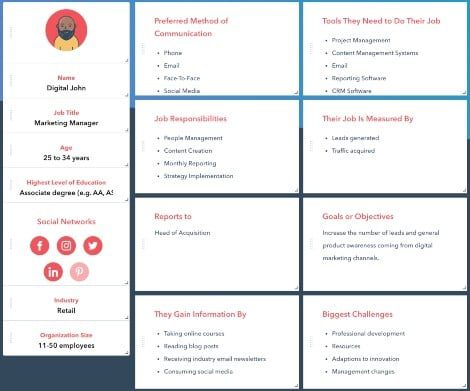
Einer der wichtigsten, aber übersehenen Bereiche der Produktforschung sind Ihre Kunden.
Dies ist der Bereich, in dem Voreingenommenheit das Ergebnis wirklich beeinträchtigen kann, und Annahmen können Teams von Anfang an zum Verhängnis werden.
Make My Persona ist ein völlig KOSTENLOSES Tool von HubSpot, mit dem Sie Ihre Buyer Personas aufbauen, erstellen und ausbauen können. Alles von Name, Alter, Verantwortlichkeiten, Tools, die sie für ihre Arbeit benötigen, und mehr. Manchmal haben wir zwar eine Vorstellung von Personas im Kopf, aber wenn wir sie konkretisieren, können wir anfangen, Dinge zu erkennen. Nicht zuletzt, was unsere Kollegen über unsere Zielgruppe vermuten, was wir vielleicht nicht wissen oder was nicht stimmt.
Das bedeutet, dass Sie sich nicht nur ein Bild davon machen können, für wen Sie etwas entwerfen, sondern auch testen können, ob Ihre Ideen richtig sind. Diese frühzeitige Identifizierung bedeutet, dass Sie eventuelle Probleme, Fehler oder Versäumnisse sehr früh im Prozess erkennen können.
SIE SAGEN:
"Ich höre oft, dass User Research wichtig ist, aber nur dieses Tool motiviert mich, Daten aus meinem Kopf in eine Ressource zu überführen, die mit anderen Teammitgliedern geteilt werden kann. Ich mag es. Einfach zu benutzen." Rezensent auf ProductHunt
Hotjar

Sie wären schockiert, wie viele Tools, Anwendungen, Produkte und mehr unter schlechtem Design leiden. Noch schockierender wäre es zu sehen, wie wenige Teams tatsächlich etwas dagegen unternehmen.
Hotjar ist eine Heatmapping-Software, die dabei helfen kann, all diese Mottenlöcher in Ihrem Design aufzuzeigen. Auch wenn Sie den neonpinken Text auf einem elektro-blauen Hintergrund lieben, zeigt Hotjars Tracking, dass die Leute nicht wirklich sehen können, was sie lesen und verwirrt werden.
Jedes Mal, wenn Sie über eine mobile App geflucht haben, die Sie nicht "auf das Ding klicken lässt!!!!", hätte ein Heatmapping-Tool das Problem lösen können.
Seien Sie nicht das Produkt, bei dem die Leute ihre Geräte aus Frust an die Wand werfen. Führen Sie Untersuchungen und Tests durch, um sicherzugehen, dass Sie nicht durch die unangenehmen Dinge, die Sie vermissen, geschädigt werden.
Die Premium-Funktionen von Hotjar sind nicht mehr auf der Website zu sehen, aber sie bieten einen kostenlosen Plan an, mit dem Sie loslegen können.
SIE SAGEN:
"Beste Plattform zum Verständnis des Benutzerverhaltens" G2 Reviewer
UXTweak
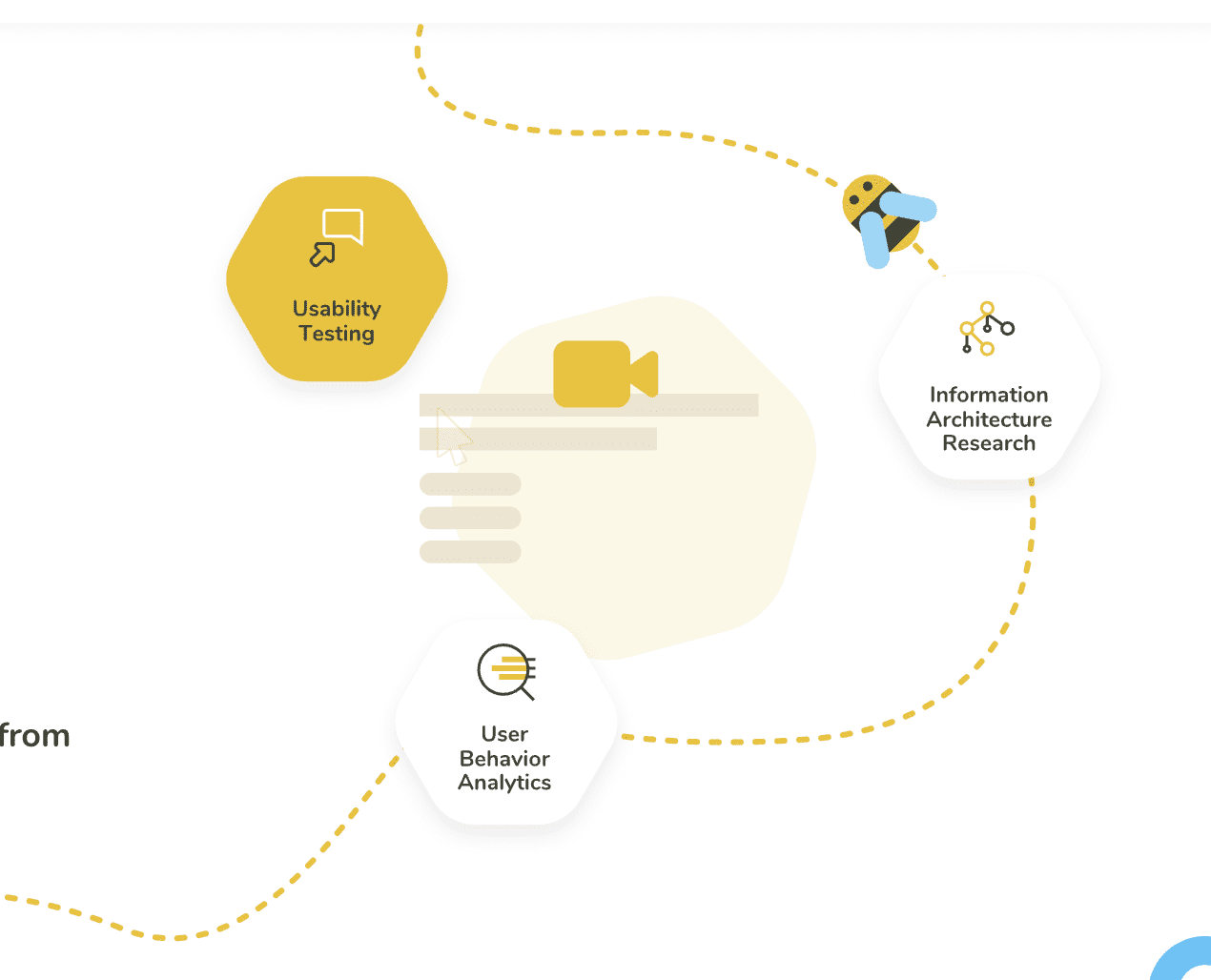
Mit diesem cleveren kleinen Tool können Sie die hübschen Entwürfe, die Sie in Figma erstellt haben, wirklich auf die Probe stellen. Sie können interaktive Testszenarien erstellen, um zu sehen, ob die Benutzer die Designs intuitiv nutzen können, und ihr Verhalten verfolgen, um tiefere Einblicke in die Interaktion der Benutzer mit Ihrem Produkt zu erhalten.
UXTweak verwendet Heatmapping, Click-Tracking und vordefinierte Ergebnisse, um zu beurteilen, ob Ihre Prototypen erfolgreich sind oder ob Sie sie noch einmal überarbeiten müssen. Darüber hinaus kann UXTweak Ihnen auch dabei helfen, die Teilnehmer zu gewinnen.
Es gibt drei Möglichkeiten:
- Erstellen Sie Ihren Prototyp und geben Sie den Link an diejenigen weiter, die das Produkt testen sollen.
- Erstellen Sie eine interaktive Testgruppe mit Ihren eigenen Website-Besuchern und Kunden
- Nutzen Sie das UXTweak-Benutzerpanel, um Feedback von qualifizierten Benutzern zu erhalten
Es beginnt mit einem kostenlosen Plan für einen Benutzer und eine aktive Studie, der sich auf 153 € / Monat erhöht, die jährlich für eine Lizenz berechnet werden. Für mehrere Lizenzen sind Rabatte verfügbar.
SIE SAGEN:
"UX-Tool für die Neugestaltung/den Aufbau von Websites, die wirklich nutzerzentriert sind" G2 Reviewer
Produktkartei

Productboard ist eines der leistungsfähigsten Produktmanagement-Tools auf dem Markt.
So bleiben Sie immer auf dem Laufenden, was wann veröffentlicht wird, und können das Kundenfeedback in einem übersichtlichen Format einsehen.
Mit den eigenen Worten von Productboard:
"Productboard hilft den Produktteams zu verstehen, was die Kunden brauchen, Prioritäten zu setzen, was als Nächstes entwickelt werden soll, und alle an der Roadmap auszurichten.
Wir haben zwar ein gewisses GEFÜHL, was Roadmaps angeht, aber jeder in der Produktforschung braucht einen Plan. Mit einem Plan und klaren Zielen, die für alle Beteiligten leicht zu dokumentieren sind, wird die Durchführung der Forschung einfacher. Product Board als Produktforschungstool hilft Teams, organisiert zu bleiben, während sie Entscheidungen treffen, die ihre Produktstrategie unterstützen.
Es ist in mehreren Versionen erhältlich: Essential, Pro, Scale und Enterprise. Die Preise liegen zwischen $20 und $80 pro Maker/Monat, je nach Kaufplan. Die B2B-Pläne, Scale und Enterprise sind Preis auf Anfrage.
SIE SAGEN:
"Productboard ist eine großartige Ergänzung für jeden agilen Workflow" G2-Rezensent
Airtable
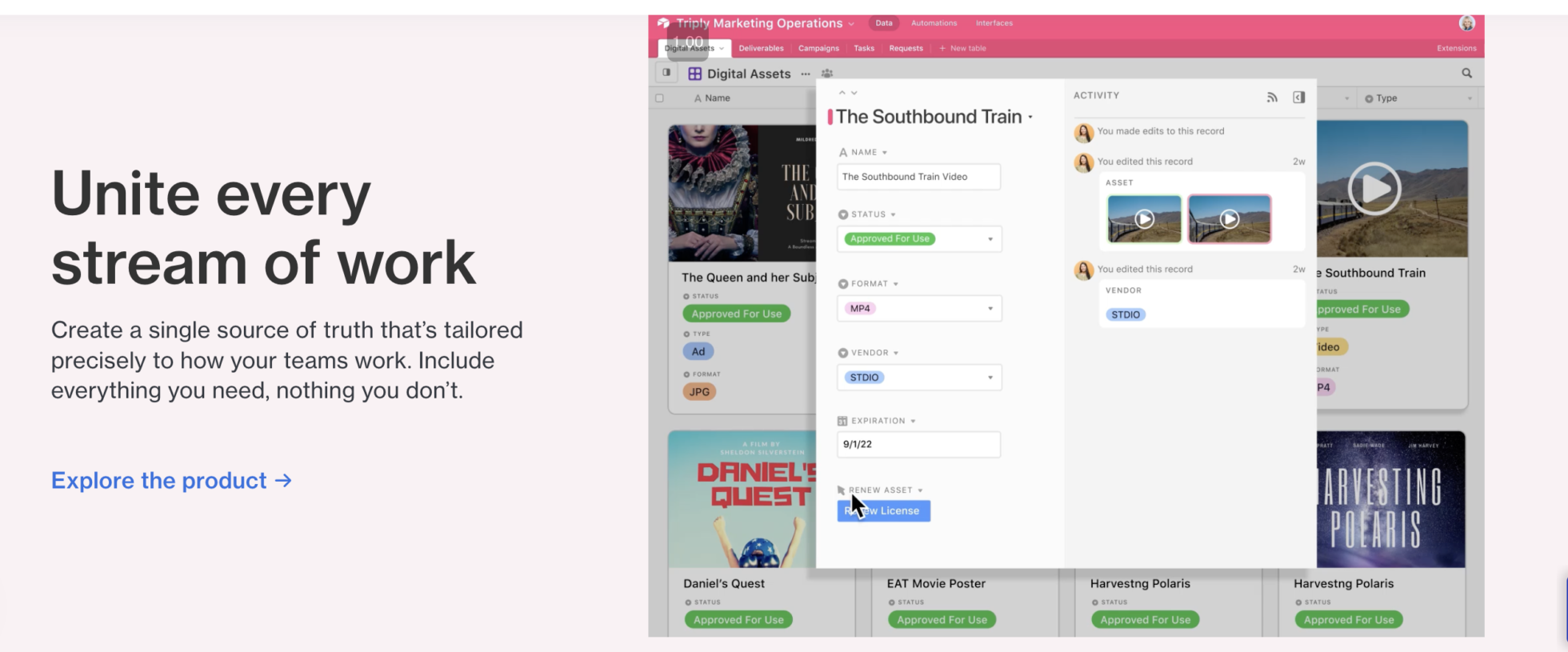
Viel, viel Forschung ist großartig! Je mehr Sie über Ihre Zielgruppe, Ihr Konzept, Ihr Produkt und Ihren Markt wissen, desto besser wird Ihr Angebot sein.
Doch mit der schieren Menge an Informationen, die Sie besitzen, wächst auch die Herausforderung, diese strukturiert zu halten. Verschiedene Mitglieder des Produkt- und des weiteren Teams müssen verschiedene Dinge tun, wofür unterschiedliche Arten von Informationen erforderlich sind.
Das ist gut, wenn alles gut organisiert ist, schön und übersichtlich, für jeden nutzbar. Aber das ist schwer zu erreichen.
Airtable ist, in Ermangelung eines besseren Begriffs, die perfekte Haushälterin für die Produktforschung. Alle Ihre Informationen können in Airtable eingespeist und geordnet werden. Mit einer übersichtlichen, transparenten und leicht zu verwaltenden Ansicht ist es einfach, echte Erkenntnisse zu erkennen und sicherzustellen, dass alle Aspekte abgedeckt sind.
Betrachten Sie es als die Marie Kondo des Produkts. Es verschafft Ihnen die Einblicke, die Sie brauchen, und macht es gleichzeitig unglaublich einfach, das herauszuarbeiten, was für das Gesamtbild nicht relevant ist.
Mit Airtable können Sie z. B. ein Repository für Benutzerfeedback erstellen. Sie können auch sicherstellen, dass das Feedback an die richtige Stelle, das richtige Team, die richtige Person oder Initiative weitergeleitet wird. Das bedeutet, dass alle, die mit einbezogen werden müssen, dies auch tun. Niemand lässt den Ball fallen, weil alles klar zu sehen ist.
Außerdem gibt es ein dynamisches Scoring für Funktionen, das die Aussagen Ihrer Kunden erfasst und Ihnen datengestützte Hinweise darauf gibt, woran Sie als Nächstes arbeiten sollten.
Airtable lässt sich auch mit Slack, Salesforce, Gmail, Zendesk und anderen integrieren, so dass Sie es ganz einfach in das digitale Ökosystem Ihres Teams integrieren können.
Airtable beginnt mit einer kostenlosen Stufe für Einzelpersonen und steigt bis zu $20 pro Benutzer/Monat für Teams und $45 pro Benutzer/Monat für Unternehmen.
THEY SAY:
"Airtable - Tabellenkalkulation auf Steroiden" G2 Reviewer
Proto.io
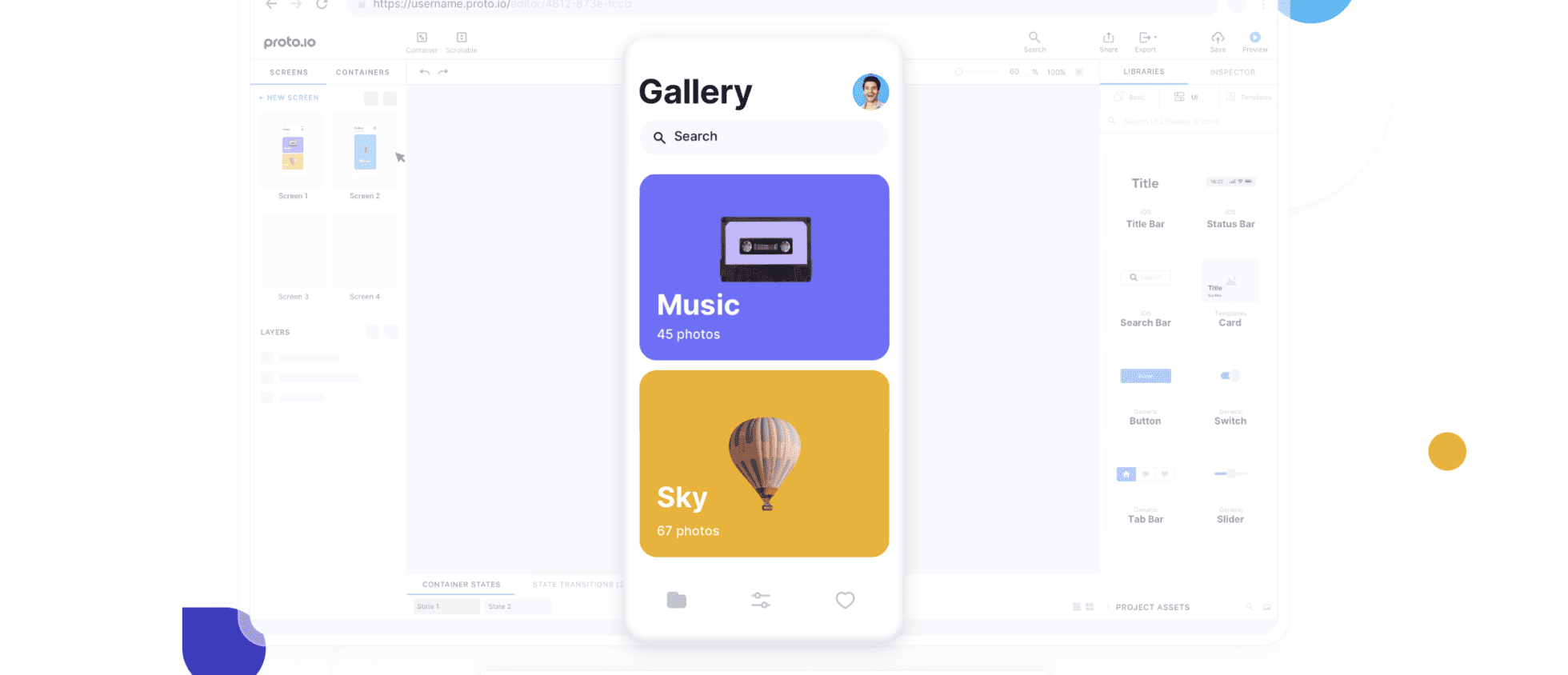
Das Prototyping ist ein wesentlicher Schritt im Zyklus der Nutzerforschung. Durch die Entwicklung und Erstellung von Prototypen stellen Sie sicher, dass Ihre Ideen gültig und umsetzbar sind.
Dann gibt es eine solide Grundlage für die Umsetzung, und Sie können mit Ihrem Geschäftskonzept selbstbewusster vorgehen. Mit einem Prototyp haben Sie auch etwas Greifbares, zu dem die Leute Stellung nehmen können. Sie können ein Feedback zu einem "Ding" erhalten, statt zu einem abstrakten Konzept.
Das ist der Grund, warum Proto.io so cool ist: Es ist eine Plattform für die Erstellung von High-Fidelity-Prototypen, die aussehen und sich anfühlen wie die realen Dinge.
Mit Proto.io können Sie den Prototyp Ihrer mobilen oder Web-App schnell und einfach entwerfen, entwickeln, testen und freigeben.
Ohne Programmierkenntnisse können Sie komplexe interaktive Prototypen mit nur wenigen Klicks erstellen. Die Software verfügt außerdem über Tools für die effektive Zusammenarbeit von Teams mit Kommentaren, Überprüfungsforen, Benachrichtigungen und mehr.
Proto.io beginnt bei $24 pro Monat für das Basispaket für Freelancer (1 Benutzer), obwohl Sie möglicherweise den Startup-Plan ($40/Monat) benötigen, wenn Sie größere Projekte haben, die erweiterte Funktionen wie unbegrenzte Benutzer und benutzerdefiniertes Branding erfordern. Es gibt weitere Stufen wie Agency ($80/Monat) und Corporate ($160/Monat). Diese werden alle jährlich berechnet.
THEY SAY:
"Einfach und schnell einen Prototyp erstellen und veröffentlichen." G2-Rezensent
Geschickt
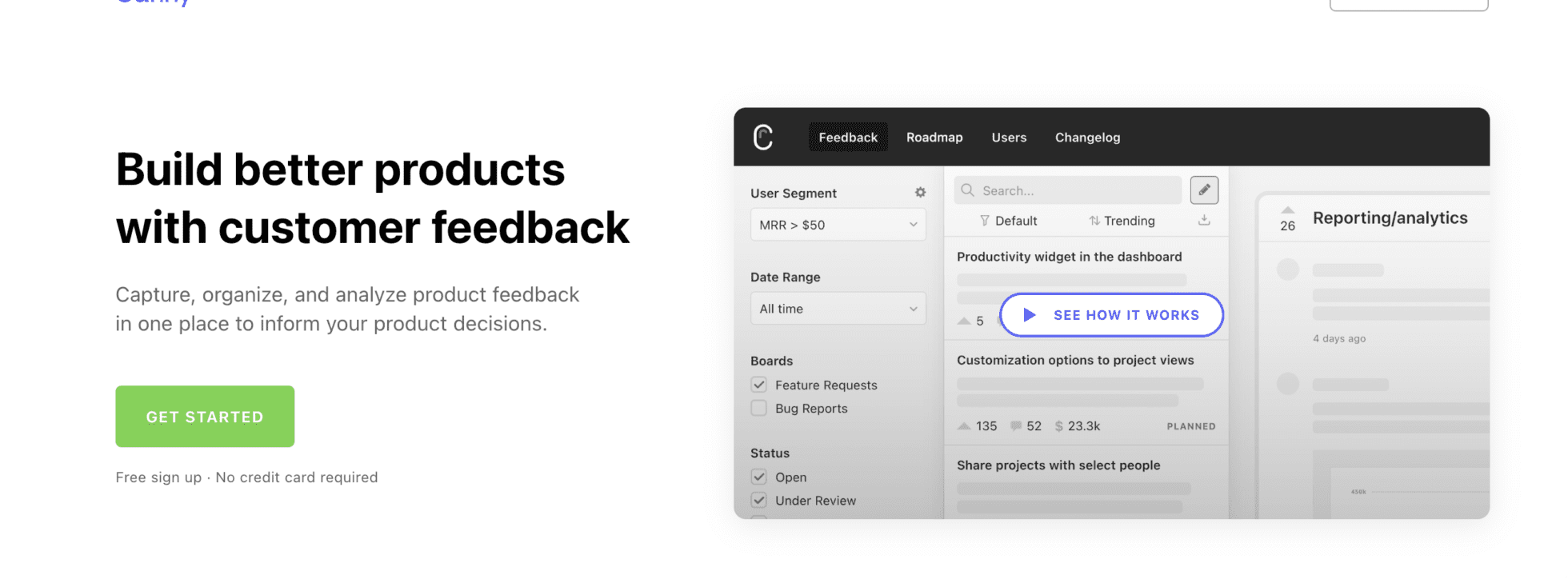
Canny ist eine Kundenfeedback-Plattform, die Ihnen hilft, Ihre Zielgruppe besser zu verstehen.
Wie chaotisch das Produktmanagement manchmal sein kann, weiß Gott. Mit diesem Tool können Sie Feedback sammeln und Dinge automatisch zusammenfassen, um Ihr Team und die gesamte Produktstrategie zu informieren. Dann stellt es Ihnen alle Daten und Details zur Verfügung, um Ihre internen Teams auszurichten.
Sie müssen lediglich in Ihrem Produkt einen Link zu Canny einrichten, und schon können die Nutzer mit minimalem Widerstand Feedback geben.
Wenn die Daten eingehen, fasst das System sie zusammen und erstellt ein solides Bild von den Schmerzen, Wünschen und Gefühlen der Kunden und gibt Ihnen eine klare Strategie für die nächsten Schritte vor. Es bringt auch Informationen aus Slack, Sasleforce, HubSpot, Intercom und mehr ein,
Neben einer cleveren Kundensegmentierung können Sie bei der Einführung einer neuen Funktion auch alle, die sie angefordert haben, benachrichtigen. So schließen Sie den so wichtigen Kreislauf zwischen Produktforschung und Ergebnis für die Nutzer.
Wenn Sie mit einer kostenlosen Stufe beginnen, können Sie alle grundlegenden Funktionen ausprobieren. Der Starter-Plan kostet 79 $/Monat, während der Growth-Plan Sie 359 $/Monat kostet. Es gibt auch eine Business-Option für diejenigen, die mehr Flexibilität suchen.
SIE SAGEN:
"Eines der besten Tools zur Erfassung von Feedback". G2-Rezensent
Sprig

Sprig ist ein leistungsstarkes Tool, mit dem Sie asynchron Einblicke in Ihre Kunden gewinnen können. Es hilft Ihnen, Feedback von Nutzern zu sammeln und es in verwertbare Erkenntnisse umzuwandeln. Sprig bietet auch Zugang zu verschiedenen Analysewerkzeugen wie Stimmungsanalyse und Net Promoter Score (NPS).
Während die Maut Daten und Analysen sammelt, wirbt sie für sich selbst als eine Möglichkeit, das Nutzererlebnis zu verbessern. Schluss mit "die Daten sagen dies", aber die Ergebnisse stimmen nicht überein.
Sprig nimmt Dinge wie Umfragen, gibt ihnen aber einen Kontext. So können Sie produktinterne Umfragen nutzen, um besser zu verstehen, wie Kunden auf Ihre neuen Funktionen reagieren, und Einblicke erhalten, die Zahlen nicht offenbaren können.

Das Tool ermöglicht auch das Prototyping und Designtests. Interaktive Prototypen, Konzepttests und vieles mehr fließen in eine zentrale Datenbank ein, die den Zugriff, die Bezugnahme und die Diskussion erleichtert. Und was noch besser ist: Es lässt sich mit 12 der wichtigsten Design-Tools integrieren.
Die Umfragen der Plattform sind außerdem in hohem Maße anpassbar und können verwendet werden, um kurze Umfragen, Abstimmungen oder sogar personalisierte Konversationen zu erstellen. Sprig lässt sich mit anderen beliebten Plattformen wie Slack, Google Suite und Intercom integrieren, um die gemeinsame Nutzung von Daten zu erleichtern.
Es gibt einen kostenlosen Plan und kostenpflichtige Preise beginnen bei 175 US-Dollar pro Monat für den Basisplan bei jährlicher Abrechnung.
THEY SAY:
"Ein leistungsstarkes Tool, um Kundeneinblicke asynchron zu erhalten" G2 Review
Begriff
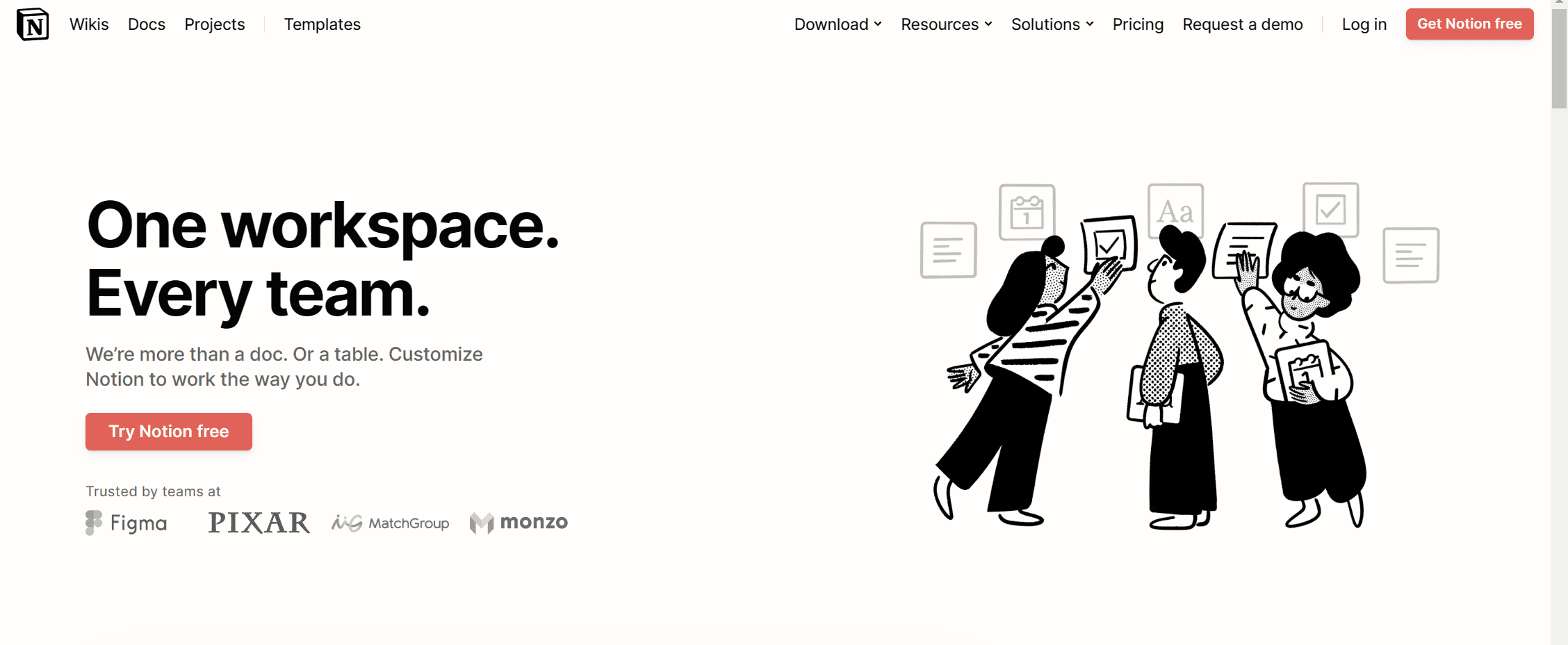
Notion ist ein ganz besonderes Tool, das nicht nur im Bereich der Produktrecherche-Tools zu finden ist. Notion ist eine Wissensdatenbank, eine All-in-One-Arbeitsplatzplattform. Es ermöglicht den Nutzern, alles von Notizen bis hin zu Projektmanagement-Tools an einem Ort zu speichern und zu organisieren.
Für jeden, der in der Produktforschung tätig ist, ist es von entscheidender Bedeutung, dass er auf all diese Daten zugreifen und sie problemlos aktualisieren kann. Und Notion ist ein unglaublich intuitives Tool, das im Vergleich zu anderen produktbasierten CRM-Optionen wenig kostenintensiv ist.
Das Beste an Notion ist, dass es in hohem Maße anpassbar ist. Sie können eine gebrandete Seite mit Aufgaben und Zeitplänen neben Ihren Marketingmaterialien, Designdokumenten, Kundenfeedback usw. erstellen. Außerdem können Sie mit der Plattform Informationen in Echtzeit aktualisieren und sogar mit anderen Plattformen wie Slack integrieren.
Auch wenn es sich nicht um ein aktives Tool für Kunden oder Klienten handelt, so ist es doch ein großartiges Repository, in dem alle Informationen auf eine Art und Weise gesammelt werden, die zu Ihrer Unternehmens- und Produktmanagementstruktur passt.
Warum viel Geld für ein System ausgeben, das nicht ganz passt, wenn Sie Ihr eigenes anpassen können?
Darüber hinaus hat Notion seine eigene GPT-gesteuerte "Ask AI" eingeführt, die unglaublich nützlich ist, um den Produktforschungszyklus zu inspirieren, aber auch direkt mit Tools wie tl;dv integriert werden kann.
Das bedeutet, dass Ihre Nutzerforschungsinterviews, Highlights und mehr automatisch in Notion für alle Beteiligten und das gesamte Team integriert werden können. Dies beseitigt viele Barrieren und demokratisiert den Prozess mit einer sekundären, einfach zu bedienenden, zugänglichen Plattform, die alle Daten und Erkenntnisse zusammenhält.
Die Preisgestaltung von Notion ist auch ziemlich gut, mit einem kostenlosen Plan, der eine unbegrenzte Anzahl von Mitarbeitern zulässt, und einem kostenpflichtigen Plan, der bei 8 $ pro Benutzer/Monat beginnt und bis zu 15 $ pro Benutzer/Monat für Unternehmen reicht. Es ist eines der erschwinglichsten Produktforschungstools mit einer benutzerfreundlichen Oberfläche, großartigen Funktionen und vielen Integrationen. Das neue AI-Add-on kostet $8 pro Mitglied/Monat bei jährlicher Abrechnung - oder $10 pro Mitglied/Monat bei monatlicher Abrechnung.
THEY SAY:
"Leistungsstarkes Tool für die Zusammenarbeit in Produktentwicklungsteams" G2 Reviewer
Produktforschungs-Tools FTW!
Die Produktrecherche kann ein mühsamer Prozess sein, der durchgeführt werden MUSS, aber er muss nicht kompliziert sein.
Es gibt so viele großartige Tools, die diesen Prozess einfacher und effizienter machen.
Sprig ist ein großartiges Tool für die Datenerfassung und -analyse. Gleichzeitig eignet sich Notion perfekt für die Erstellung einer anpassbaren Wissensdatenbank, die Teams jeder Größe zur Speicherung und Organisation von Informationen nutzen können. Für das Prototyping gibt es eine große Auswahl an Optionen, darunter Figma, Proto.io und wiederum Sprig.
Und schließlich können Sie all dies zum Leben erwecken und echtes, umsetzbares Feedback und Stimmungen von Ihren Nutzern erhalten.
Der Einsatz von tl;dv, nicht nur zur Sammlung von Nutzerinterviews und Feedback, sondern auch für Ihre internen Besprechungen, kann einen Wendepunkt darstellen. Es wird nie wieder einen verlorenen Kommentar geben. Alles wird dokumentiert und ist durchsuchbar, so dass Sie alle Proof-of-Concept- und qualitativen Erkenntnisse gewinnen, die Ihre Produkte erfolgreich machen.
Denken Sie daran, dass eine gute Planung und Vorbereitung eine schlechte Leistung verhindert. Eine gute Produktforschung ist der Unterschied zwischen der Einführung des nächsten iPhones oder Netflix und Ataris ET Game und dem Zune-Player.














